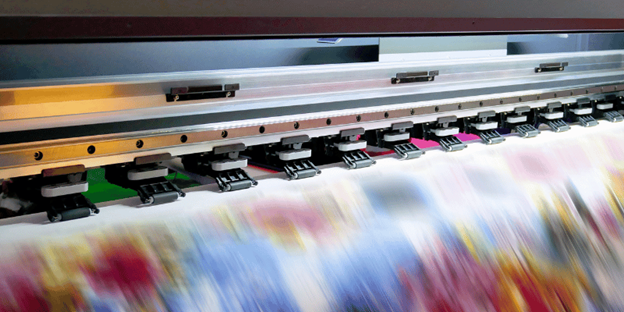
Any business that sends statements and documents to addressees, including personal or confidential information, has two choices. A company can handle this in-house or outsource it. In comparing in-house printing vs. outsource printing, each has pros and cons. Evaluating each option will reveal which is the best for your organization in terms of costs, accuracy, compliance, and quality.
In-House Printing vs. Outsource Printing: The Pros of Each
To start your assessment, let’s look at the pros of each category.
In-House Printing Pros
Keeping all transactional mail in-house offers these pros:
Remain in complete control of operations.
If these activities occur within your organization, you can manage all aspects of the process. However, remember that total control comes with a hefty price tag.
Update documents quickly.
Letters and statements often change. When everything is internal, these should occur with speed. Having a specific workflow for this will impact how fast it happens.
Outsourcing Printing Pros
There are numerous benefits to outsourcing transactional mail:
Reduce costs.
As noted, running an in-plant is expensive. It includes many different costs, and you have to calculate the total to understand the price of each letter. In-house printing racks up expenses related to equipment, technology, labor, materials, postage, and overhead (e.g., rent, energy, security).
You’ll yield immediate savings by outsourcing by eliminating all these from your budget. You’ll still pay for postage at a much lower rate, as transactional print companies use optimization strategies to guarantee the best rate.
Improve accuracy.
Errors in transactional print and mail create mis-mailings. As a result, you could face noncompliance fines and reputational harm. While no process is perfect, you may not have the most advanced processes that drive accuracy.
Those include leveraging technology and perfecting workflows. Accuracy at PCI Group is 99.9999% as a result of this. We use sophisticated inserting machines along with mini cameras that scan the barcodes of each document to ensure the right document goes in the correct envelope.
Additionally, we apply strategies like Lean Manufacturing to develop fine-tuned workflows that consider every task.
Enhance security.
Data security is another area where you can make gains. You may question how another company could keep data as secure as you do. The answer is that transactional print and mail companies are secure by design. Everything they produce must follow rigid rules and protocols.
In assessing the security prowess of a partner, ask questions about how they mitigate risk and practice cybersecurity. At a minimum, they should have firewalls, intrusion prevention systems (IPS), data encryption, and physical security.
Elevate compliance.
Compliance is essential for every piece of mail you send. Depending on your industry and the contents, you may need to comply with multiple regulations. When outsourcing to a transactional print company, this is their specialty and part of every run they complete.
They understand each regulation and follow them precisely with defined processes, technology, and protocols. Further, they audit these workflows regularly to improve compliance. Their focus on compliance in every piece of mail ensures minimizing risks.
Achieve reliable quality.
The quality of your documents matters in terms of repeatable processes and consistent appearance. The best approach is quality assurance (QA) versus quality control (QC). With QA, printers apply the concepts of Lean Manufacturing and Six Sigma. Our use of these strategies has created 270 standard works, which are documented processes for every activity. Our QA team focuses on removing risk and waste, and we conduct 96,000 standard work audits each year.
The second part of quality is how your statements and documents look. It involves the branded components and content of your letters. Be sure to assess the print quality so the documents align with your brand identity.
 In-House Printing vs. Outsource Printing: The Cons of Each
In-House Printing vs. Outsource Printing: The Cons of Each
Now, let’s review the cons of in-house printing vs. outsource printing.
In-House Printing Cons
Basically, you can look at the pros of outsourcing and clearly see the cons of doing it yourself.
For a recap, these are the cons you may face.
- Costs increase every year: Keeping an in-plant running is expensive. Equipment and technology run in the millions and need to be maintained and upgraded. Materials like paper and ink are constantly increasing, as is postage. Plus, you have labor and all the overhead expenses to keep the operation going. Even if you reduce the volume, you’re unlikely to see any reduction.
- The expense of in-house printing cuts funding to core competencies: If you’re always flowing money into this cost center, you won’t be able to use it for things to help your company grow.
- Compliance isn’t your specialty: While you’re well-versed in the regulations you need to follow, it’s not your singular focus. It is with an outsource provider. You may suffer compliance obstacles as a result.
- Dynamic printing may be outside your capabilities: Transactional print companies employ the White Paper Factory (WPF). The WPF framework is a best-in-class, end-to-end solution. It combines fully digitally composed files with in-line print production and intelligent insertion. The result is ultra-secure, highly accurate, variable data-generated statements. White rolls of paper feed into printers, producing customized letters without limitations. With the ability to print dynamically, you no longer need to pre-print templates.
- Your accuracy missteps may accumulate: Accuracy directly impacts compliance and quality. Without specially designed processes throughout the lifecycle, you could be at risk. You can eliminate virtually all of this when you outsource.
Outsourcing Printing Cons
Outsourcing to just any printer is the quickest road to cons. That’s why it’s critical to evaluate your options on the market. Some overall cons include:
Visibility could be limited.
Some printers may not provide access to the lifecycle of the job. You may only get feedback when they receive the data and complete the job. We want our customers to have complete visibility, and they do with trakPCI. It’s a business document tracking system that lets you monitor the status of jobs in real time. You can also pull reports on just about any metric, submit changes to letters, view archives, and more.
Printers may lack expertise in your industry.
Another possible con is if the outsourcing partner isn’t familiar with your industry. Ask questions about this to ensure they are the best fit.
They may not be postage experts: To gain the best rates for postage, a print and mail company must use a variety of tactics. Those would include:
- Reducing waste from inaccurate or duplicate addresses through address hygiene tools
- High-volume presorting
- Usage of the USPS Intelligent Mail® barcode (IMb), a 65-bar Postal Service™ barcode used to sort and track letters
- Commingling, which further categorizes letters by ZIP codes
- Mail piece standardization options
When deciding your next move, consider all these pros and cons of in-house printing vs. outsource printing.
Get All the Benefits of Outsourcing with PCI Group
Thousands of regulated companies trust us as their print and mail partner. Our commitment to accuracy, compliance, security, and quality ensures that they get all the benefits of outsourcing. With reduced costs and improved processes, you can refocus on the core competencies of your company.
Learn more about outsourcing and its advantages by contacting us today.


